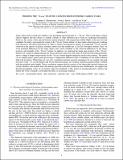PROBING THE “30 μm” FEATURE: LESSONS FROM EXTREME CARBON STARS
Author(s)
Speck, Angela; Volk, Kevin; Messenger, Stephen Joseph
DownloadMessenger-2013-PROBING THE _30 mu m.pdf (2.251Mb)
PUBLISHER_POLICY
Publisher Policy
Article is made available in accordance with the publisher's policy and may be subject to US copyright law. Please refer to the publisher's site for terms of use.
Terms of use
Metadata
Show full item recordAbstract
Some carbon-rich evolved stars exhibit a very prominent spectral feature at ~"30 μm." The C-rich nature of these objects suggests that the carrier is a sulfide, carbide, or other substance apt to form in a reducing environment. However, the carrier of this spectral feature remains disputed, with magnesium sulfide (MgS) as the most favored candidate. In order to investigate the carrier of the "30 μm" feature further, we have taken a dual approach, studying both laboratory and observational data. In order to obtain a homogeneous sample, we studied the "30 μm" feature observed in the spectra of galactic extreme carbon stars that exhibit the 11 μm SiC absorption feature. Thus, we avoid potential differences in the target objects that could contribute to the observed differences in the shape, position, and strength of the "30 μm" feature. In addition, we analyzed the shape and position of the "30 μm" features for a range of sulfide minerals for which laboratory data exist. Our study of observed astronomical features shows a range of shapes and positions for the "30 μm" feature despite similarities in the source objects. The nature of our sample argues against grain processing or temperature differences due to hardening of the stellar radiation field with evolution. While there are very few correlations between spectral parameters for our sample, the peak positions of the ~11 μm absorption and 30 μm emission features do correlate, and these peak positions correlate with the modeled optical depth. These correlations suggest that the carriers of the observable spectral features are closely related to one another and to the density/pressure in the dust formation zone. Furthermore, we suggest that the blue-broadening of the 11 μm feature cannot be attributed to SiS[subscript 2] based on existing laboratory spectra, but further lab work is needed to investigate the effect of increasing oxidation.
Date issued
2013-02Department
Massachusetts Institute of Technology. Department of Earth, Atmospheric, and Planetary SciencesJournal
The Astrophysical Journal
Publisher
IOP Publishing
Citation
Messenger, Stephen J., Angela Speck, and Kevin Volk. “PROBING THE ‘30 Μm’ FEATURE: LESSONS FROM EXTREME CARBON STARS.” The Astrophysical Journal 764, no. 2 (February 1, 2013): 142. © 2013 The American Astronomical Society
Version: Final published version
ISSN
0004-637X
1538-4357